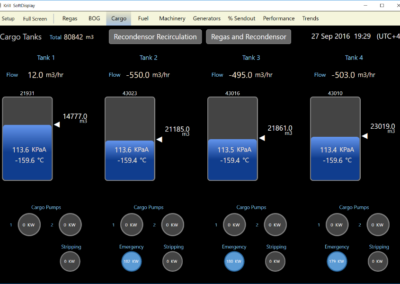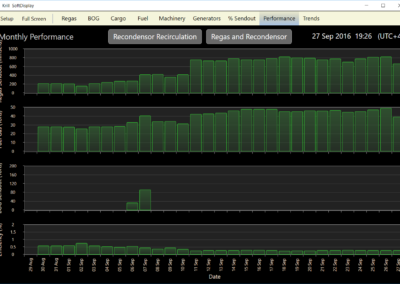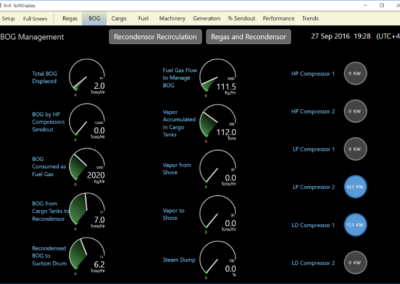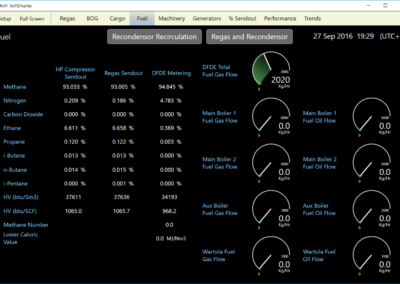LNG Regasification Efficiency Monitoring

Krill Regasification Monitoring Center
The Krill Regasification Monitoring Center (KRMC) provides real time data monitoring of the entire LNG regasification process. Presented on a series of easily accessed menu-driven display screens, the data collected by the KRMC delivers all the information necessary for the LNG manager to accurately monitor the entire LNG regasification process including system status, system health and system efficiency. The Krill KRMC is designed for use in both land-based and marine applications.

KRMC captures both liquid and gas flow data and additional information collected from system data sensors fitted at critical points, and interfaced directly with onboard computer control systems. Clear, menu-driven HMMI display graphics allow the operator a clear overview of all parts of the system and incorporate individual system information screens including: Regasification process, Cargo Tanks status, Machinery monitoring, Fuel Consumption, Pressure / Temperature / Flow / Load Management information, and additional custom screens as demanded by the specific regasification unit system configuration.

In the page above, regassed send-out rate is continuously compared with the current fuel gas usage rate in order to determine how much energy is used to regasify and send natural gas to shore. Other pages below display the real time status of the entire LNG Regasification process.
Using Microsoft SQL server database technology to record all sensor data on board, with 15-second resolution and storage capacity of over one year, the collected data is displayed onboard, and the onboard database with the collected sensor data, is copied and synchronized with the centralized Microsoft Azure cloud-based database server. The cloud-based database server has no limit on data storage, so the copied data is never lost, even if it is deleted on the vessel database. Any Internet access can be used, including microwave, cellular or satellite uplink with at least 256Kbits/sec bandwidth.
This replicates the onboard data display monitor, thereby delivering unlimited number of onshore managers with a complete overview of system operation, its health and its efficiency. The data transfer operates continuously in real time.

What is LNG Regasification?
Regasification involves the use of a specialized Regasification Unit, which regasifies liquid LNG (typically imported via LNG tankers) to a natural gas pipeline grid. A regasification unit may be based on land or on a vessel permanently moored near a gas pipeline (FSRU).
The regasification process is complex. Every part of the system requires careful monitoring both in terms of its own integrity and in relation to changes in all other parts of the system, to ensure efficient processing and optimized cost savings.

The basic regasification process calls for one or more high-volume vaporizers, using large quantities of water as a heating medium to gasify the liquid LNG stored in tanks. The seawater is usually pre-heated using the heat generated in an onboard steam power generation system. Gas resulting from vaporization will head through a pipeline and connected to a delivery grid for distribution.
The regasification process, if not carefully controlled, can lead to a significant loss of product. Liquid LNG is stored at a very low temperature of about -162 degrees C. in large cargo tanks. Despite the insulation, surrounding ambient temperatures will gradually cause the LNG temperatures to rise and vaporization of some of the LNG occurs, generating ‘Boil-off Gas’ (BOG).
For maximum efficiency, BOG is re-captured instead of allowing it to be vented to the outside atmosphere. The re-captured gas can be delivered to the gas delivery grid as part of normal delivery or re-liquified and returned to the cargo tanks to prevent LNG inventory depletion.





